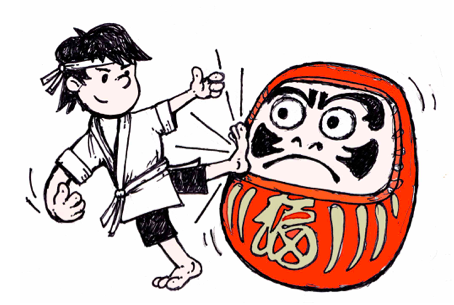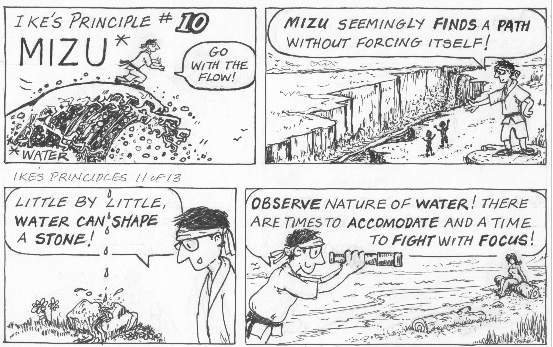 NANA KOROBI, YA OKI
NANA KOROBI, YA OKI
FAILING/FALLING 7 TIMES, GETTING BACK UP 8 TIMES -sg
Last Sunday, I was treated to lunch by Chef Tak. He explained, "In the restaurant business our day often starts later in the day. Regardless of the evening hours, the proper greeting is 'Ohayo Gozaimasu' or the direct translation of Japanese, "Good Morning."
Chef Tak further explains that his coworkers must have the attitude of 'getting up' and being of service.
The above drawing by Sam Goto hangs prominently above my bed. It's time for me to awaken, get up, and refine my new life.
Bodhidharma was a Buddhist monk who lived during the 5th/6th century AD. The history of the Daruma starts with the monk, but has been commercialized. For my purpose it symbolizes goal setting and persistence. Goal setting was explained in a previous blog. Persistence is symbolized by the weighted bottom so when knocked over, the doll rights itself.
Last night, I explained to Michelle, "Don't be afraid to fail." We are therefore practicing the skill of getting up again.
![USING THE EXAMPLE OF WATE...]() USING THE EXAMPLE OF WATER
USING THE EXAMPLE OF WATER
TO FIND OUR OWN PATH IN LIFE
We’re in the rainy season here in the Seattle Northwest. When the rivers are overflowing in the wrong places, water is not appreciated. But appreciating water scenically, hydrating nature and harnessing the power of water is how we live well.
The same goes for the “energy” that we all have for making decisions, communicating and getting things done. It helps us live well.
The difference between water & energy is that we can see and feel water. On the other hand, we can’t see energy, but we can produce it - going with the flow, persisting, focussing:-)
![What were the circumstances i...]() What were the circumstances in Japan & US promoting Japanese Immigration to US & Seattle around 1900?
What were the circumstances in Japan & US promoting Japanese Immigration to US & Seattle around 1900?
The 1868 Meiji Restoration, brought Japan out of 200 years of isolation (foreigners as well as Japanese citizens were killed or imprisoned setting foot on or returning to Japanese soil). The Samurai Shogun was overthrown and the Emperor restored. New political, financial and military leaders chose European imperialism and the American model to transform their country as quickly as possible into a major power. Therefore, “GOING TO AMERICA” was publicized and encouraged.
America was expanding westward and still needed cheap labor. The Civil War was over and slave labor was no longer available. The 1882 Chinese Exclusion Act, enacted because American politicians reacted to the outcry that the Chinese were taking all the good jobs, created a shortage of labor. Especially, workers for railroad and mining were still needed and the Japanese were willing to work hard for cheap. The average $1 (whites earned $2.75) a 10-hour day in America compared to 16 - 25 cents a day earned in Japan.
Japan was experiencing over population, economic problems and climate related farm crop failures. My Grandpa, K Tsukamaki, explains, “In my farming village (Hiroshima, Japan), every other household had someone who had come to America. They would come back to Japan in their fancy western clothes and brag about all the money they made. My father saw no future for his three sons in Japan. My father was 47-years-old (average life expectancy was age 50) when he came to Seattle in 1897 as a railroad worker. He made three trips to America.
I was 19-years old when I immigrated in 1905. Since I was the oldest son I didn’t have to worry, but many of the young men in the village left Japan so they wouldn’t be conscripted into the Japanese army in the fight against Russia.”
Japanese emigration to the United States for the 30 plus years from 1890 to 1924 totaled 275,000. In only one year, 1913, there was 283,000 Italians who entered the U.S. The 1924 Immigration Act and Asian Exclusion act stopped all immigration from Japan, for the same political reasons the Chinese were excluded 40 years before.
Tsukamaki’s father was clearly aware of the politics on both sides of the Pacific ocean, reading newpapers and books like AMERICA BOUND. He arranged for his three sons to emigrate. The second son sneaked into the United States in 1923, using an underground network. The third son, Ted, was brought as a 15-year-old minor on the last boat in the spring, before the exclusion July 1, 1924.
Ted joined the class at the Orillia, WA, grade school and quickly advanced. Ted is remembered in the community as a baseball all-star catcher on the White River Valley team.
- If you are a bloguru member, please login.
Login
- If you are not a bloguru member, you may request a free account here:
Request Account




